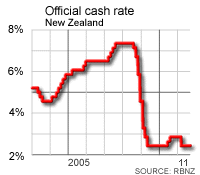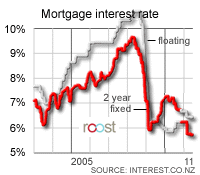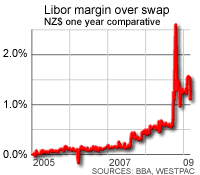 Reserve Bank Governor Alan Bollard finally acknowledged today that New Zealand's obsession for buying property with fixed rate mortgages that are funded by foreign debt has blunted the power of monetary policy.
That's the only conclusion to be reached from the surprisingly large cut in the Official Cash Rate (OCR) of 50 basis points to 7.5%.
The only disappointing thing is that Bollard has realised the bluntness of monetary policy during the easing phase of the cycle rather than the tightening phase. If he had swung his interest rate axe harder in 2004, 2005 and 2006 then he may not have the problems he has now.
To illustrate the point it's worth having a look at the track of OCR changes since Bollard's appointment in September 2002. His first decision was to cut the OCR three times by 25 basis points each time in April, June and July of 2003. Bollard then hiked rates 6 times by 25 basis points each through 2004.
It was through this time that it became clear to the Reserve Bank and the public that these hikes were not having any impact on the housing market because banks were borrowing money cheaply on international money markets and lending it out via fixed rate mortgages at lower rates than the variable rates influenced by the OCR.
The epitome of this period was the 'Unbeatable' campaign launched by BNZ in the Spring of 2004 where it promised to have the lowest 2 year fixed mortgage rate, sparking a price war that drove fixed mortgage rates down at a time when the Reserve Bank was putting up the OCR. Now 87% of our mortgages are on fixed rates.
This highlighted the impotency in the short term at least of monetary policy through 2004 and 2005 and also into late 2006 as many of the 'Unbeatable' era mortgages were refinanced (often with bigger loans). This cheap, easy credit helped spark a second wind for the housing market through late 2006 and through 2007.
New Zealanders borrowed NZ$85 billion from foreign banks and investors from 2003 to the end of 2007 to take advantage of low global interest rates. This was during a period when the US Federal Reserve held its funds rate at 1% in the wake of the September 11 attacks, unleashing a wave of cheap credit around the world. Much of it was ploughed into the developed world's housing markets. Now that credit-fed housing bubble is bursting and banks and mortgage lenders are either withdrawing their loans or not lending any more so they can rebuild their balance sheets to cope with the losses. This is a global deleveraging event we have not seen since the Depression.
Reserve Bank Governor Alan Bollard finally acknowledged today that New Zealand's obsession for buying property with fixed rate mortgages that are funded by foreign debt has blunted the power of monetary policy.
That's the only conclusion to be reached from the surprisingly large cut in the Official Cash Rate (OCR) of 50 basis points to 7.5%.
The only disappointing thing is that Bollard has realised the bluntness of monetary policy during the easing phase of the cycle rather than the tightening phase. If he had swung his interest rate axe harder in 2004, 2005 and 2006 then he may not have the problems he has now.
To illustrate the point it's worth having a look at the track of OCR changes since Bollard's appointment in September 2002. His first decision was to cut the OCR three times by 25 basis points each time in April, June and July of 2003. Bollard then hiked rates 6 times by 25 basis points each through 2004.
It was through this time that it became clear to the Reserve Bank and the public that these hikes were not having any impact on the housing market because banks were borrowing money cheaply on international money markets and lending it out via fixed rate mortgages at lower rates than the variable rates influenced by the OCR.
The epitome of this period was the 'Unbeatable' campaign launched by BNZ in the Spring of 2004 where it promised to have the lowest 2 year fixed mortgage rate, sparking a price war that drove fixed mortgage rates down at a time when the Reserve Bank was putting up the OCR. Now 87% of our mortgages are on fixed rates.
This highlighted the impotency in the short term at least of monetary policy through 2004 and 2005 and also into late 2006 as many of the 'Unbeatable' era mortgages were refinanced (often with bigger loans). This cheap, easy credit helped spark a second wind for the housing market through late 2006 and through 2007.
New Zealanders borrowed NZ$85 billion from foreign banks and investors from 2003 to the end of 2007 to take advantage of low global interest rates. This was during a period when the US Federal Reserve held its funds rate at 1% in the wake of the September 11 attacks, unleashing a wave of cheap credit around the world. Much of it was ploughed into the developed world's housing markets. Now that credit-fed housing bubble is bursting and banks and mortgage lenders are either withdrawing their loans or not lending any more so they can rebuild their balance sheets to cope with the losses. This is a global deleveraging event we have not seen since the Depression.
 On the way up the Reserve Bank wrung its hands and gnashed its teeth a little about the impotency of its monetary policy. In February 2006 it suggested a series of "Supplementary Stabilisation Instruments" to improve the potency of monetary policy. These monetary policy 'Viagra' suggestions included a mortgage interest rate levy, the ringfencing of property investing losses inside LAQCs and possible loan to value ratio limits for bank lending.
Nothing has come of this, partly because fixed mortgage rates eventually rose sharply, implying that monetary policy has some form of longer term potency. I think this is debateable. A major reason for the sharp increase in fixed mortgage rates from mid 2007 was the Global Credit Crunch, which increased wholesale interest rates and the margins that banks are forced to pay each other for credit on international markets.
So now the Reserve Bank has a potency problem on the way down as well as on the way up.
On the way up the Reserve Bank wrung its hands and gnashed its teeth a little about the impotency of its monetary policy. In February 2006 it suggested a series of "Supplementary Stabilisation Instruments" to improve the potency of monetary policy. These monetary policy 'Viagra' suggestions included a mortgage interest rate levy, the ringfencing of property investing losses inside LAQCs and possible loan to value ratio limits for bank lending.
Nothing has come of this, partly because fixed mortgage rates eventually rose sharply, implying that monetary policy has some form of longer term potency. I think this is debateable. A major reason for the sharp increase in fixed mortgage rates from mid 2007 was the Global Credit Crunch, which increased wholesale interest rates and the margins that banks are forced to pay each other for credit on international markets.
So now the Reserve Bank has a potency problem on the way down as well as on the way up.
 Depending on who you talk to, bank funding costs are up by 150-200 basis points because of the stresses in the global financial system linked to the US Sub-Prime mortgage debacle and the resulting Credit Crunch.
There was a real risk that a 25 basis point cut today might not have been passed on by banks to borrowers. The July 24 cut was passed on to fixed mortgage borrowers but not to variable rate borrowers.
Bollard was explicit today in saying that a major reason for the size of the cut was that he wanted to give the banks room to pass on the OCR cut to borrowers. That's because there is a big tranche of 2 year fixed rate mortgages set to roll over in the next three months at potentially higher rates than when they were taken out in the spring of 2006. This would have seen an effective tightening of monetary policy. This is actually the second 'echo' of the 'Unbeatable' fixed mortgage bulge going through the market.
So Bollard has decided that to get around this monetary policy impotency on the way down as well as on the way up he needs to swing the blunt instrument harder.
"We wanted to frontload it a bit to get these (mortgage) rates down a bit," Bollard told Bloomberge News, adding that there were still "pipeline effects" of higher rates still flowing through to fixed rate borrowers. "This time it was important that the banks did have room to cut rates," he said, referring to a rise in borrowing costs for the banks.
Let's hope he swings just as hard again on the way up. No one would want to think he favours swinging harder in the rate cutting part of the cycle than in the rate hiking part of the cycle.
A final note. This is the first time Bollard has ever moved the OCR by 50 basis points. Every other move has been 25 basis points. It's also the first 50 basis point move since Don Brash cut the OCR by 50 basis points each on September 19 2001 (8 days after the 9/11 attacks) and on November 14, 2001.
Is the situation on September 11 2008 really as serious as it was on September 19 2001?
Price setters will be the judge. I fear their judgement will be an inflationary one.
Depending on who you talk to, bank funding costs are up by 150-200 basis points because of the stresses in the global financial system linked to the US Sub-Prime mortgage debacle and the resulting Credit Crunch.
There was a real risk that a 25 basis point cut today might not have been passed on by banks to borrowers. The July 24 cut was passed on to fixed mortgage borrowers but not to variable rate borrowers.
Bollard was explicit today in saying that a major reason for the size of the cut was that he wanted to give the banks room to pass on the OCR cut to borrowers. That's because there is a big tranche of 2 year fixed rate mortgages set to roll over in the next three months at potentially higher rates than when they were taken out in the spring of 2006. This would have seen an effective tightening of monetary policy. This is actually the second 'echo' of the 'Unbeatable' fixed mortgage bulge going through the market.
So Bollard has decided that to get around this monetary policy impotency on the way down as well as on the way up he needs to swing the blunt instrument harder.
"We wanted to frontload it a bit to get these (mortgage) rates down a bit," Bollard told Bloomberge News, adding that there were still "pipeline effects" of higher rates still flowing through to fixed rate borrowers. "This time it was important that the banks did have room to cut rates," he said, referring to a rise in borrowing costs for the banks.
Let's hope he swings just as hard again on the way up. No one would want to think he favours swinging harder in the rate cutting part of the cycle than in the rate hiking part of the cycle.
A final note. This is the first time Bollard has ever moved the OCR by 50 basis points. Every other move has been 25 basis points. It's also the first 50 basis point move since Don Brash cut the OCR by 50 basis points each on September 19 2001 (8 days after the 9/11 attacks) and on November 14, 2001.
Is the situation on September 11 2008 really as serious as it was on September 19 2001?
Price setters will be the judge. I fear their judgement will be an inflationary one.
Opinion: Bollard takes a bigger swing with a blunt instrument
Opinion: Bollard takes a bigger swing with a blunt instrument
11th Sep 08, 12:49pm
by

We welcome your comments below. If you are not already registered, please register to comment
Remember we welcome robust, respectful and insightful debate. We don't welcome abusive or defamatory comments and will de-register those repeatedly making such comments. Our current comment policy is here.